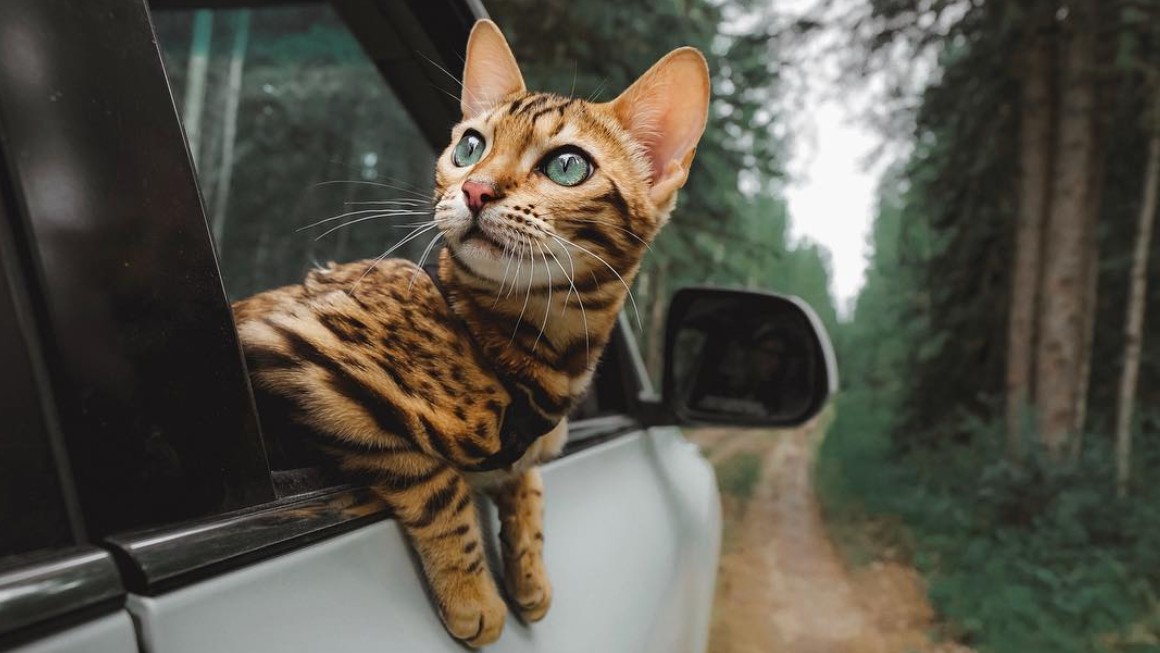Hiking with cats: top 10 tips to get safely out on the trail
Does hiking with your cat sound appealing? Our must-read guide explains everything you need to know before you hit the road.

While no-one raises an eyebrow if you take your trusty pooch for a walk, hiking with cats is more unusual. In recent years more people have been trialling trailing with their feline friend, and it’s a fantastic way to build a bond, share adventures and help maintain your pet’s weight and fitness. Before you tell Kitty to get her walking paws on, there are some things to think about to help you both stay safe and enjoy your time outdoors.
Cats have very acute senses and get a lot of stimulation from exploring new places. While some cats will happily roam for hours, others are more timid and could find the whole thing overwhelming. Felines who are inquisitive and confident will have a ball joining in your trip, while shyer cats will be happier at home. The perfect trip away hiking with your cat needs a little forward planning, so you’ll need to invest in some essential trip before your trip. These could include one of the best cat harnesses, a travel water bowl, some kitty snacks for emergencies and a supply of water. Read on for our top tips on everything you need to know to keep you both safe and happy on your adventure.
1. Respect your cat
It’s really important before you set off with your little ball of fur to give some thought to their personality. If you have a cat that’s shy, reserved, and loves nothing more than being curled up on your lap, trying to get them to accompany you on a hike might be asking too much.
A lot of cats find being away from home to be a very stressful experience, but there are some playful breeds, like the Bengal, Abyssinian, and American Bobtail that absolutely adore adventure and would likely be highly put out if you tried to leave them behind! Take your cues from your cat and if you think the outdoors would be more distressing for them than enjoyable, don’t force them to join you.
2. Invest in a good harness and leash
While it’s probably never going to be their favorite thing in the world to wear, you’ll find most outgoing cat breeds will happily wear a harness and leash if it means they get to come and explore the great outdoors with you.
We recommend that you start harness and leash training a few weeks prior to your first adventure together as this will give your cat a chance to get used to the feel of it. There are several types of cat harnesses, so you might want to try out a couple and see which one is the most comfortable for your kitty to wear.
3. Consider a cat backpack
A harness and leash are important if you’re wanting to give your kitty a bit of freedom to explore when you’re on your hike, but for those times when they’re feeling too tired to keep walking, having one of the best cat backpacks with you can be a real lifesaver.
Get the best advice, tips and top tech for your beloved Pets
There are several different styles of cat backpacks available, so it’s worth shopping around to see which one you think you and your kitty will prefer. Some have windows at the front that allow your cat to peer out, while others have open tops that allow your feline friend to stick their head out and survey their surroundings more closely. Others are forward facing, which means you can interact with your cat while you’re hiking.
Some pet parents have asked the question, ‘are cat backpacks cruel?’ but the good news is, they’re no different from a cat carrier. In fact, a backpack is a great way of giving your cat's paws a rest while also ensuring they stay safe and secure. It’s also a safe way of traversing any difficult sections of the route, such as roads or towns. Just be sure to keep them in their harness with their leash clipped to the backpack to ensure they don’t try and escape!
4. Practice at home
Even if you have a cat that can’t get enough of being outside, you’ll still want to practice with them in your own backyard first before trying to take them further afield. Start by putting them in their harness and walking them around your garden, watching their behavior to see how they’re responding.
If that exercise goes positively, the next step would be to take them to a local park to get them used to being around other people and animals. You might like to begin by having them in a backpack to help them feel safe and secure and then progressing to popping them down onto the ground for short periods of time wearing their harness and leash.
Again, monitor them closely, watching for signs of stress, such as dilated pupils or tail thumping. If they seem curious, confident and content, then those are all great signs that the two of you are ready to hit the trails.
5. Train your cat for the car journey

When it comes to traveling with a cat, preparation is the key to success. Even the most social and outgoing of kitties may not be overly keen on being in the car, so we recommend you take some time to get them used to the sensation of a moving vehicle.
While you can put them in the car just in their harness and leash, for safety purposes, we advise purchasing one of the best cat carriers as this will ensure your feline friend stays secure in the event of an accident.
Just like with harness training, start slowly when it comes to training your cat to travel in the car. Get them used to the car itself by leaving the doors open and allowing them to explore the inside at their own pace.
Once they’re comfortable being in the car with the doors open, hop in with your cat and close the doors. Spend some time playing together in the car for short bursts over the course of several days. You can then progress to popping them into their carrier and placing the carrier in the car.
If all of that goes well, you’re ready for the final step - getting your cat used to being in a moving car. You can start by simply reversing your car to the end of the driveway and then back up again. After doing that a few times, take a couple of short trips around the block.
As with any kind of training, you’ll find that lots of positive reinforcement in the form of praise, affection and the best cat treats will help your kitty to associate the car with good things. Once your feline friend sees the car as a fun and enjoyable place to be, you’re ready for your first trip together.
6. Choose a quiet trail
When it comes to your first hike, it’s best to opt for a quiet trail so as not to overwhelm your feline friend. It’s also a good idea to look for one with a narrow trail as cats find these easier to stick to and follow, and if you can go for one that makes it compulsory for dogs to be on leads, this will also help your cat to feel safer.
7. Purchase a GPS tracker
Investing in one of the best pet trackers may feel like an added expense, but if you’re going to be hiking a lot with your cat, they really are wonderful when it comes to providing you with additional peace of mind.
Most pet trackers are lightweight, comfortable to wear, and a breeze to fit, and provide up to the minute data on your cat's location. If for any reason you were to become separated from your feline friend, a pet tracker will allow you to quickly and easily locate them.
8. Make sure your cat’s vaccinations are up to date
Before taking your cat hiking, it’s worthwhile stopping by your vet and getting your kitty checked over to make sure they’re in good health. You’ll also want to make sure they’ve had all the appropriate vaccinations before hitting the trails and that you’re using one of the best flea treatments for cats to keep them protected from pesky parasites, including ticks and mosquitoes.
9. Be sure to pack plenty of supplies
First things first, you’ll want to make sure you have plenty of food and water on hand to ensure your kitty has all the energy they need for their hike and to avoid dehydration along the way. If you’re going to be gone all day, the best dry cat food is far easier and less messy to take along with you than wet cat food and you may also find a collapsible water bowl is easier to transport than a regular one.
We also recommend that you take along a decent pet first aid kit just in case there are any injuries while you’re on the trail. If you’re unsure about what to include, have a chat with your vet who will be able to advise you. It’s also worth having your vet’s number with you in case of an emergency.
10. Expect the unexpected
While your time exploring the great outdoors with your much-loved moggy will hopefully go smoothly, it’s always a good idea to be prepared for all potential occurrences. Snakes, mountain lions, coyotes and hawks are all predators that pose a risk to your kitty, so it’s important to be aware of these if you’re hiking in an area where they’re prevalent.
It’s also worth noting that not everyone follows the rules when they’re hiking and this is especially true when it comes to dogs being on leads. A lot of owners will let their dogs walk or run freely if they’re in a fairly quiet area, so it’s possible that at some stage your cat will encounter another fellow fur ball who may decide they want to come up and say hello.
Always follow your cat’s cues and watch their behavior closely. If they suddenly become stressed, agitated or panicked, it could be that they’ve already sensed a potential threat that you can’t yet see. At times like this, it’s best to pick your cat up and pop them into their backpack until you can suss out what’s caused their behavior to change.
Keen to hit the trails with your feline friend but need to take a bit of a trip to get to your desired location? Our guide to traveling with a cat is packed full of useful information to help your adventure go smoothly.

Kathryn is a freelance writer who has been a member of the PetsRadar family since it launched in 2020. Highly experienced in her field, she's driven by a desire to provide pet parents with accurate, timely, and informative content that enables them to provide their fur friends with everything they need to thrive.
Kathryn works closely with vets and trainers to ensure all articles offer the most up-to-date information across a range of pet-related fields, from insights into health and behavior issues to tips on products and training.
When she’s not busy crafting the perfect sentence for her features, buying guides and news pieces, she can be found hanging out with her family (which includes one super sassy cat and a kitten), drinking copious amounts of Jasmine tea and reading all the books.
She has written for a range of publications, including Fit&Well, Top Ten Reviews, LiveScience, Goodto, and Product Hunt.
